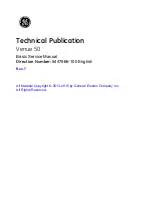
User guide
BABYS
C
REEN
ECH001XN121-A4 – 07/2022
35
Chapter 4. Otoacoustic emission (TEOAE and DP-gram)
4.5 DP-gram
4.5
DP-gram
to obtain the necessary instructions about the needed equipment and the setup.
4.5.1.0
Measurement
The
BABYS
C
REEN
is a screening device, so there is no
special configuration required. After connecting the
OAE Probe, all you have to do is select the ear when
starting the measurement.
Frequencies to be tested, validating conditions and maximum duration of the test can be modify in the advanced
setting of the DP-gram (see subsection
.
In this menu, it is also possible to modify the intensity used in
« Screening
»
mode.
The
DP-gram
measurement window then opens. The
curve is displayed with default values (0
dB
for the sig-
nal,
–25
dB
for the noise) on frequencies that were selected
during configuration.
Click on the "
Start
" button to start measurement.
For each frequency, a series of calibrations are performed automatically to determine if the measurement conditions
are optimal to obtain usable results. In this context, the system may asks the user to make choices in order to adjust the
measurement parameters as best as possible:
•
"Low signal. Check leak. Continue?"
: The signals F1 and F2 and are too low compared to their set value (at
least 20dB too low). This may be due to the wrong positioning of the probe, more precisely a sealing problem
between the probe plug and the ear canal. It is advised to click on “No”, reposition the probe and restart the meas-
ure. However, if you are sure of the probe’s positioning, it is possible to continue by clicking on “Yes”.
•
"Too much signal, Check eartip. Continue?"
: The signals F1 and F2 and are too strong compared to their set
value (at
least
20dB too much). This may be due to an incorrect positioning of the probe, more precisely a probe
plug pushed too far into the ear canal. It is advised to click on “No”, reposition the probe and restart the measure.
However, if you are sure of the probe positioning, it is possible to continue by clicking on “Yes”.
Once the calibration is complete, the measurement window is displayed:
If you are not familiar with the settings and how modifying them can affect test results, do not attempt to
change them. A bad setting can make the next measurements unusable and irrelevant.
This first step of the measurement is a self-calibration which last few seconds (2 or 3 seconds). During
this first step, the surrounding noise must be kept as low as possible.
















































